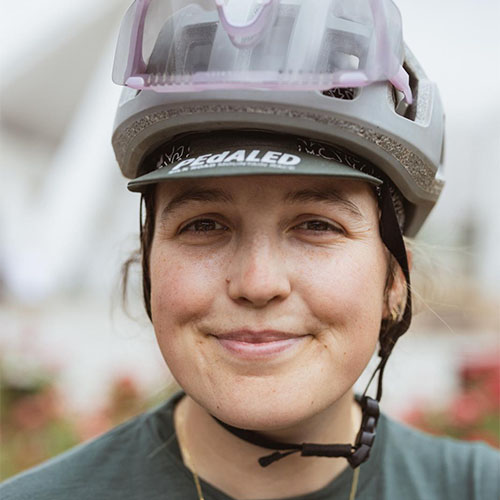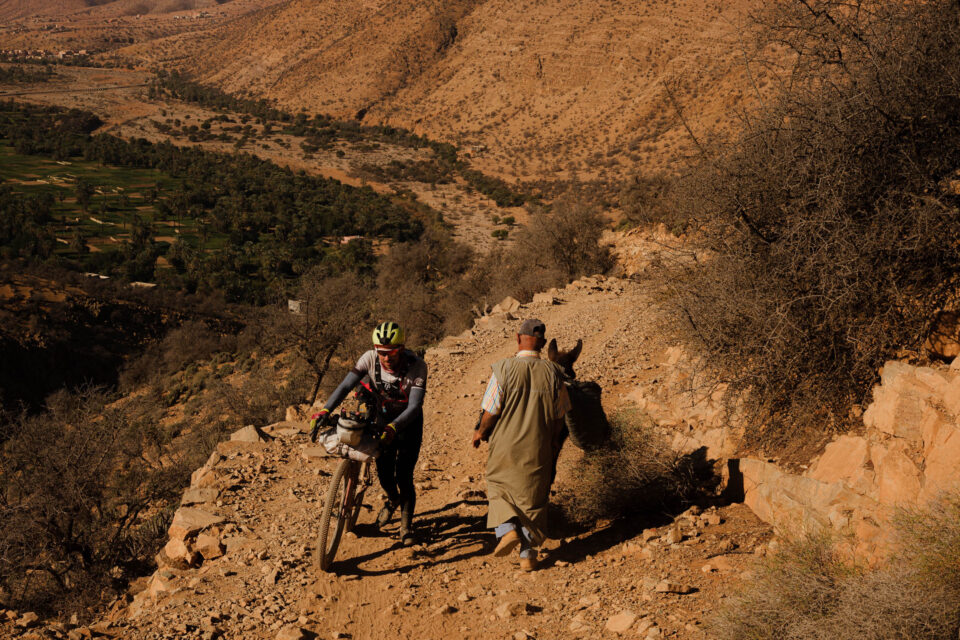With the 2025 Atlas Mountain Race officially completed, we’re wrapping up this year’s coverage with an inside look from the event’s media manager, Mel Webb. Find her reflection on the race paired with a selection of stunning photos from Nils Laengner, Lloyd Wright, and Stephen Shelesky here…

Photos by Nils Laengner, Stephen Shelesky, and Lloyd Wright
The Atlas Mountain Race has a way of drawing you in. Whether you’re on the start line, following along from afar, or chasing riders through the mountains with a camera in hand, it’s impossible not to get wrapped up in the rhythm of it all. I thought stepping back from racing this year might leave me with immense FOMO, wishing I could be riding instead of documenting, but what I found was something even more rewarding. To be part of a team and all work together on something bigger—bringing the story of this race and its riders to the world—that’s not lost on me.

Telling the story of an event like this is a challenge. Once the clock starts, it does not stop until the finish line, and neither do the riders. The race is more or less a round-the-clock affair for everyone. We were constantly checking dots, planning routes, and hoping to be in the right place at the right time. Some moments lined up perfectly; others slipped just out of reach. Our media team—three photographers, a videographer, control car drivers, and I—spread out across the course, following the race as best we could. The days blurred together, and my screen time rivaled the hours I’d normally spend pedaling (peaking at 20 hours on February 8th and averaging 14 to 16 hours throughout the rest of the race). But looking back, all I feel is pride. Our little team came together to produce what I think is some of the best ultra-cycling coverage yet. The riders poured their hearts and souls into reaching the finish line, and we did the same in hopes of doing justice to their stories.
A Fast Year
This year’s field was the strongest we’ve seen. The course changes slightly each edition due to shifting conditions—landslides, flooding, river levels—but this year’s route was close to 2023’s, with the return of Telouet Pass. That meant we had a direct comparison for the winning time, and Alex McCormack set the fastest yet, finishing 15 minutes ahead of Robin Gemperle’s winning time in 2023.
The gaps at the front were razor-thin. Leaders arrived at checkpoints minutes apart, and for much of the race, Alex McCormack and Benedek Borsos were never more than 40 minutes from each other. In the end, Benedek finished just 90 minutes after Alex for second place. After racing for over 1,200 kilometers, Kevin Benkenstein and Drikus Coetzee still couldn’t manage to shake one another. In the end, they shared third place, five and a half hours after Alex.

That depth didn’t just exist in the men’s race. The women’s field was the strongest we’ve seen yet, with the top finishers placing higher than ever in the overall rankings. When the first women’s winner, Jenny Tough, crossed the line at the inaugural edition in 2020, she placed 67th. Since then, we’ve seen our women’s winner steadily climb the overall general classification—from 67th, to 45th, to 22nd, to 15th, and now, this year, 8th overall. While the number may feel small, 30 women raced this year, making up 11% of the field, compared to 8% last year. We made it a big focus this year to present equal coverage in hopes that more women can see themselves represented and take part in future editions.

Morocco has developed a reputation as a difficult place for women to travel alone, and while there are valid concerns, taking part in the Atlas Mountain Race offers a safety net—not just for women but for all participants. Though the race is self-supported, and we do our best to stay at a distance to preserve that sense of solitude, there are still three control cars on course, a medical team, and a 24/7 Race HQ ready to respond in an emergency. These are safety precautions that you wouldn’t have if you were touring on your own. The added presence of other riders out on the course adds another layer of security and peace of mind.
A Race of Contrasts
The start of the Atlas Mountain Race is hard. Riders climbed into snow and ice on the first pass, conditions that made it clear right away what they’d signed up for. Telouet’s switchbacks lead into a singletrack or hike-a-bike, depending on who you ask. This year, with patches of deep snow, it tested everyone.
Cap 184, Niel Copeland, summed it up well:
“Imagine a steep, rocky gully that’s maybe 80 centimeters wide—two feet for the Americans listening. It’s filled with boulders, sharp rocks, and occasionally buried under a snowdrift. Every few hundred meters, you come across a 50-meter-wide section of snow to navigate. It drops at about a 20% gradient. I’ve been mountain biking for many years, and I consider it unrideable in those conditions. How the front guys rode it down baffles me.”

Alex McCormack was seen riding nearly the whole thing, sliding on the snow banks. Robin Gemperle and his pair partner, Lucas Strittmatter, managed too, “not with dignity,” as Robin put it, but they made it down, slipping and sliding with one leg out.
This race is one of contrasts. The nights are cold, the days hot. Riders shift constantly between freezing and overheating, adjusting and readjusting, layering up and stripping down, never settling into any one thing for long. Regulating body temperature became one of the race’s biggest challenges, adding another layer of fatigue, and it was particularly difficult with the freezing overnight temperatures this year. Many riders come to Morocco looking for a winter escape, and while they got that during the day, the long nights certainly reminded them that it’s still February.
Stories From the Finish Line
We had a record number of applications this year, and a full start line of 265 riders rolled out from Marrakech. By the time the cutoff hit, 147 had reached the finish in Essaouira, putting the finisher rate at 55%, right in line with previous editions.
With so many standouts and inspirational rides, it’s impossible to tell the story of every finisher, though here are just a few. Kyrgyzstan had its first finisher, Cap 201 Vadim Fatkulbaianov. He’s done Silk Road three times and can now call himself an AMR finisher.

Caps 319A&B Shona and Rich, riding tandem, came back after an unlucky crash last year that ended their race early and made it all the way to the coast. I caught up with them at CP2, where they had run into the same pesky kids that led to their crash last year. This time, they were able to outrun them, Shona remarking that her interval training had paid off.
At 19, Carlotta Schumacher, Cap 23, became the youngest AMR finisher ever. She was overwhelmingly enthusiastic whenever we met her despite having possibly the most punctures of anyone in the race. All of her bags were handmade, some falling apart at the finish, and our friends from Albion aided in getting them repaired to help her make her journey home. She rode all the way to the start from her home in Germany and will be making her way back home by bike in the coming days.
Then there was Cap 06, Canadian rider Alex Maclean, who arrived in Marrakech to find his bike bag had made it, but none of his gear had. With some borrowed kit from Nelson and an outpouring of offers from other riders, he made it to the start line and got the job done. When I caught up with him at the omelette shop in Ait Saoun, a small town before CP2, he shared how much that support meant to him and that this race was so much more than a bike race but rather a true adventure.
A Different Perspective
As I said before, I thought stepping back would make me miss racing, but being on the media team gave me something else entirely. Racing is an individual pursuit. You focus on your own ride, your own needs, pouring all of your energy into doing whatever you need for yourself to reach the finish line. Being on the other side, I got to see the whole race unfold: how different riders handled setbacks, the moments of doubt and determination, and the sheer elation and sense of accomplishment when they crossed the finish line.
The messages from dot-watchers, the families following along, and the people new to this kind of racing who reached out after watching the coverage made me realize how much this storytelling matters. When you’re in the middle of it, it feels like you’re never getting enough out there. But looking back at everything that happened over seven days, I’m incredibly proud of what our team was able to share.

We raced around Morocco in our own way, chasing stories, sometimes getting it exactly right, other times missing a moment by just a few minutes. That’s how it goes. It’s going to take quite some time for this one to sink in. The goodbyes at the end of the race are always bittersweet, but we won’t be apart for long; the Hellenic Mountain Race is just under 100 days away.
Visit TheMountainRaces.cc to learn more about their upcoming events. You can also find the Hellenic Mountain Race in our events calendar.
2025 Atlas Mountain Race coverage supported by

Further Reading
Make sure to dig into these related articles for more info…
Please keep the conversation civil, constructive, and inclusive, or your comment will be removed.









